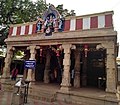
Sangameswarar temple is a temple in Bhavani, in the Erode district, of the Indian state of Tamil Nadu. It is a Hindu temple dedicated to Lord Shiva. It is 15 km from Erode, 30 km from Gobichettipalayam, 56 km from Salem and 106 km from Coimbatore.
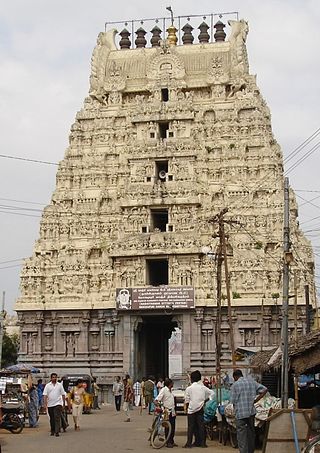
The Sri Kamakshi Amman Temple is an ancient Hindu Temple dedicated to the goddess Kamakshi, one of the highest aspects of Adi Parashakti, the mighty goddess in Shaktism. The temple is located in the historic city of Kanchipuram, near Chennai, India. The temple houses one of the 108 Divya Desams of Vishnu and is called Tirukalavanur. The temple is dedicated mainly to Kamakshi and then to Vishnu in his form of Varaha. The temple is glorified by the 6th-9th century Vaishnavite Alvars in the Naalayira Divya Prabandham. Its construction is credited to the Pallava kings, whose capital was in the same city. This temple, along with the goddesses of Madurai and either Varanasi or Thiruvanaikovil, are the important centers of Shaktism in the state of Tamil Nadu. The present temple is also known as Kamakoti Peetha or Kamakota Nayaki Kovil, where Tripura Sundari had settled after killing a demon. This ancient temple was mentioned in Perunaraatrupadai, an ancient Tamil literature that praises the renowned Sangam era. King Thondaiman Ilandiraiyan of the Pallava dynasty, who ruled Kanchipuram, constructed the temple. Kamakshi is worshipped in the shrine in 5 forms, one of them was a golden idol, which was transported to Thanjavur due to the Muslim invasions of Kanchipuram. There are no other goddess temples in the city of Kanchipuram, apart from this one, which is unusual in a city that has hundreds of traditional temples. There are various legends that account for this fact.
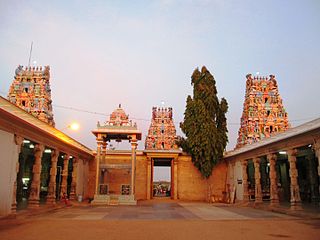
Kodumudi is a panchayat town and taluk headquarters of Kodumudi taluk in Erode district at state of Tamil Nadu, India. Kodumudi has an average elevation of 144 metres (472 feet). Also Kodumudi is an tourism spot. The holy Kaveri river and Magudeswarar temple in Kodumudi attracts thousands of pilgrims daily across South India.

Kalaiyar Kovil is a historic temple in Sivaganga District, Tamil Nadu, India. Kalayarkoil is a town in Kalaiyarkoil Block in Sivaganga District of Tamil Nadu State, India. It comes It is located 18 km towards East from District headquarters Sivaganga.466 km from State capital Chennai.

Veeraraghava Swamy Temple is a temple dedicated to the Hindu god Vishnu, located in Tiruvallur, Chennai Metropolitan City, an area and headquarters in Tiruvallur district in the South Indian state of Tamil Nadu. Constructed in Dravidian style of architecture, the temple is glorified in the Divya Prabandham, the early medieval Tamil canon of the Alvar saints from the 6th–9th centuries CE. It is counted as one among the 108 Divya Desams dedicated to Vishnu. Vishnu is worshipped as Veeraraghava Perumal, and his consort Lakshmi as Kanakavalli Thayar.

Nachiyar Kovil or Thirunarayur Nambi Temple is a Hindu temple in Thirunarayur, a village in the outskirts of Kumbakonam in the southern Indian state of Tamil Nadu, is dedicated to the Hindu god Vishnu and his wife Lakshmi. It is the sub urban region of business city of Kumbakonam.
Unjalur is a panchayat town situated in Erode district in the Indian state of Tamil Nadu. Unjalur is located about 32 kilometres (20 mi) from district headquarters Erode and 8 kilometres (5.0 mi) from Kodumudi, which is known for the Mahudeswarar, Veera Narayana Perumal and Brama Deva temple.
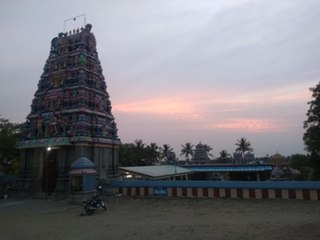
Located at Venjamangudalur near Karur, this temple is classified as one of the Kongu Naattu temples. Karuvoor Aanilai is another Shivastalam located nearby. The sanctum of this temple bears depictions of the 7 Thevara temples in Kongu Naadu.
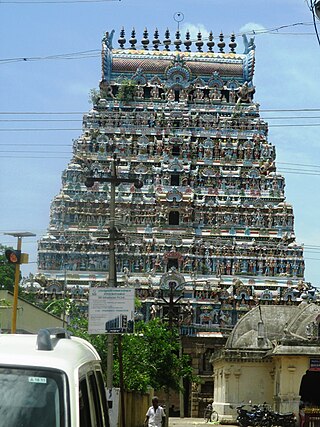
Mahalingeswaraswamy Temple, Thiruvidaimarudur is a Hindu temple dedicated to the deity Shiva, located in Tiruvidaimaruthur, a village in the South Indian state of Tamil Nadu. It is significant to the Hindu sect of Saivism as one of the seven major Shiva temples. Shiva is worshiped as Mahalingeswaraswamy, and is represented by the lingam, with his idol referred to as Jyothirmayalingam. His consort Mookambika is depicted as Devi Bruhatsundarakuchaambika or Bruhatsundarakuchaambigai amman. The lingam of the temple is believed to be the focal point for the seven consorts of Shiva. The presiding deity is revered in the 7th century Tamil Saiva canonical work, the Tevaram, written by Tamil poet saints known as the nayanars and classified as Paadal Petra Sthalam. The 9th century Saiva saint poet Manikkavacakar has sung praise about the temple in his works. Pattinattar, one of the revered saints visited this shrine many times.

The Virudhagiriswarar Temple is a Hindu temple in the town of Virudhachalam, Cuddalore district of Tamil Nadu, India. The presiding deity Virudhagiriswarar is revered in Tevaram, written by Tamil saint poets known as the nayanmars and classified as Paadal Petra Sthalam. The temple gives its name to the town of Virudhachalam. The temple is famed for the legend of Shiva forming as a mountain heeding to the prayers of Brahma.

Aiyarappar is a Hindu temple dedicated to Shiva located in the village of Tiruvaiyaru, Tamil Nadu, India. Shiva is worshiped as Aiyarappar, and is represented by the lingam and his consort Parvati is depicted as AramValarthaNaayagi. The presiding deity is revered in the 7th century Tamil Saiva canonical work, the Tevaram, written by Tamil poet saints known as the nayanars and classified as Paadal Petra Sthalam.
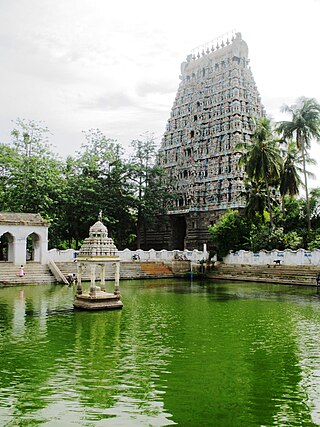
Mayuranathaswamy Temple, Mayiladuthurai or Mayuranathar Temple is a Hindu temple in the town of Mayiladuthurai in Tamil Nadu, India. The temple is dedicated to Lord Mayuranathaswamy, a form of Shiva, and has given its name to the town itself. The main icon is a lingam and the presiding deity is called Mayuranathar because the Hindu goddess Parvathi worshipped Shiva here in the form of a mayura.
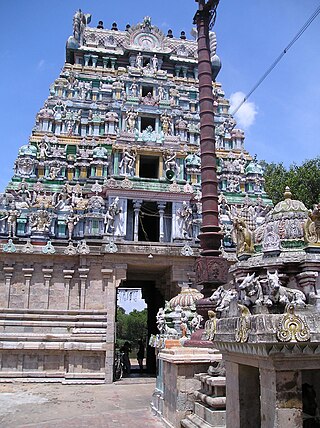
Kalyanasundaresar Temple, Nallur or Thirunallur is a Hindu temple dedicated to the deity Shiva in Nallur, Tamil Nadu, India. It is located 10 km (6.2 mi) away from Kumbakonam, 6 km (3.7 mi) east of Thirukkarugavur, and 30 km (19 mi) south of Thanjavur.

Vaithamanidhi Permual Temple is one of the nine Nava Tirupathi, the Hindu temples dedicated to Vishnu. It is located on the Tiruchendur–Tirunelveli route in Tamil Nadu, India, on the southern bank of the Thamiraparani River, 4 km from Alwarthirunagari. It is the eighth temple of Nava Tirupathi, and is named after Mars (Sevvai) and also called Kuberasthalam. Constructed in the Dravidian style of architecture, the temple is glorified in the Nalayira Divya Prabandham, the early medieval Tamil canon of the Alvar saints from the 6th–9th centuries CE. It is one of the 108 Divya Desams dedicated to Vishnu, who is worshipped as Vaithamanidhi Perumal and his consort Lakshmi as Kolurvalli.

Mela Kadambur Amirthakadeswarar Temple is a Hindu temple located at Melakadambur in Cuddalore district of Tamil Nadu, India. The historical name of the place is Tirukadambur. The presiding deity is Shiva. He is called as Amirtha Kadeswarar. His consort is known as Vidyujothi Nayaki. The temple has beautiful sculptures and the vimana is in the form of a chariot. It was built by emperor Kulottunga Chola I.
Nine Grahas Temples in Tamil Nadu is a set of nine Hindu temples, each dedicated to one of the nine planetary deities, the Navagraham in various places around the South Indian towns of Kumbakonam and Mayiladuthurai in Tamil Nadu, India. The presiding deity in most of the temples is Shiva, with a shrine dedicated to the planetary deity. Leaving Tirunallar Saniswaran Temple which is located in Karaikkal, all the other temples are located in Tamil Nadu.
Tirulokanathar Temple is a Hindu temple dedicated to Shiva, one of the main deities of Hinduism. It lies in Thakkalur in Puducherry, India.
Thanjavur Palace Devastanam is the name of a group of temples attached to the Palace Devastanams, Thanjavur, Tamil Nadu, India.

Sundararaja Perumal Temple, Salem is located on the banks of the Thirumanimutharu river at Salem, Tamil nadu, India. The temple is Classified one among the 108 Abhimana Kshethram of Vaishnavate tradition. The other significance of the temple is that it is one of the Pancha Kshethram where Maha Lakshmi was born as Bhargavi- the daughter of Maharishi Bhrigu. The other four temples of the Pancha Kshethram are Sarangapani temple, Kumbakonam, Oppiliappan temple, Nachiyar Koil and Venkateswara Temple, Tirumala. The temple is believed to be of significant antiquity with contributions at different times from Medieval Cholas, Vijayanagara Empire, Chera, Pandyas and Madurai Nayaks. The temple follows Vaikhanasa agama and the temple priests perform the pooja rituals during festivals and on a daily basis. The priests belong to the Vadakalai sect of Vaishnavism, a Brahmin sub-caste. The temple rituals are performed six times a day: Ushathkalam at 7 a.m., Kalasanthi at 8:00 a.m., Uchikalam at 12:00 p.m., Sayarakshai at 6:00 p.m., Irandamkalam at 7:00 p.m. and Ardha Jamam at 10:00 p.m. Each ritual has three steps: alangaram (decoration), neivethanam and deepa aradanai for both Ranganatha Perumal and Ranganayagi. During the last step of worship, nagaswaram and tavil are played, and religious instructions in the Vedas are recited by priests.











